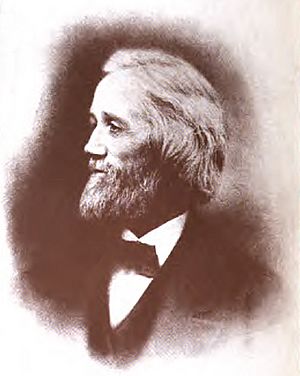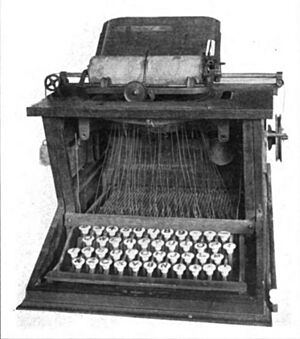Christopher Latham Sholes facts for kids
Quick facts for kids
C. Latham Sholes
|
|
|---|---|

Christopher Latham Sholes
|
|
| Member of the Wisconsin Senate from the 8th district |
|
| In office January 7, 1856 – January 4, 1858 |
|
| Preceded by | Francis Paddock |
| Succeeded by | Samuel R. McClellan |
| Member of the Wisconsin Senate from the 16th district |
|
| In office June 5, 1848 – January 7, 1850 |
|
| Preceded by | Position Established |
| Succeeded by | Elijah Steele |
| Member of the Wisconsin State Assembly from the Kenosha 1st district |
|
| In office January 5, 1852 – January 2, 1854 |
|
| Preceded by | Henry Johnson |
| Succeeded by | Samuel Hale Jr. |
| Personal details | |
| Born |
Christopher Latham Sholes
February 14, 1819 Mooresburg, Penn., U.S. |
| Died | February 17, 1890 (aged 71) Milwaukee, Wisconsin, U.S. |
| Resting place | Forest Home Cemetery, Milwaukee, Wisconsin |
| Nationality | American |
| Political party |
|
| Spouse | Mary Jane McKinney (died 1888) |
| Children |
|
| Parents |
|
| Relatives | Charles Sholes (brother) |
| Occupation | Printer, inventor, legislator |
| Known for | "The Father of the typewriter," inventor of the QWERTY keyboard |
| Signature | |
Christopher Latham Sholes (February 14, 1819 – February 17, 1890) was an American inventor. He is famous for inventing the QWERTY keyboard. Many people also consider him one of the inventors of the first practical typewriter in the United States. Besides inventing, Sholes was also a newspaper publisher and a politician in Wisconsin. He was known by names like C. Latham Sholes or Latham Sholes during his life.
Contents
Early Life and Public Service
Christopher Latham Sholes was born in Mooresburg, Pennsylvania. He later moved to Danville and worked as an apprentice printer. This means he learned the printing trade by working for someone experienced.
In 1837, Sholes moved to Milwaukee, Wisconsin. He later settled in Southport, which is now known as Kenosha, Wisconsin. In 1841, he married Mary Jane McKinney in Green Bay, Wisconsin.
Sholes became a newspaper publisher and a politician. He served in the Wisconsin State Senate from 1848 to 1849. He was also in the Wisconsin State Assembly from 1852 to 1853. Later, he returned to the Senate from 1856 to 1857.
He played a key role in ending the death penalty in Wisconsin. His newspaper, The Kenosha Telegraph, reported on a famous trial in 1851. Then, in 1853, he led the effort to ban the death penalty in the state assembly. Christopher's older brother, Charles Sholes, was also a newspaper publisher and politician.
Inventing the Typewriter
People had tried to invent typewriters since 1714. Many different versions appeared throughout the 1800s. Sholes was inspired by other inventors, especially John Pratt. Pratt's "Pterotype" typewriter was mentioned in a magazine called Scientific American in 1867. Sholes's typewriter was simpler and worked better than earlier models. This helped him get a patent and become successful.
Sholes was a newspaper editor in Milwaukee. After a strike by his workers, he tried to build a machine to set type for printing. This machine didn't work well, so he stopped. He then found a different path to inventing the typewriter.
His first goal was to create a machine that could number pages or tickets. He worked on this with another printer, Samuel W. Soule, in Milwaukee. They received a patent for their numbering machine in 1866.
From Numbering to Typing
Sholes and Soule showed their machine to Carlos Glidden. Glidden was a lawyer and inventor who worked in the same shop. He wondered if their machine could also make letters and words.
In July 1867, Sholes read about John Pratt's "Pterotype" in Scientific American. Sholes thought Pratt's machine was too complicated. He decided to build his own "typewriting machine," or typewriter.
Soule joined him again, and Glidden became a third partner. Glidden helped by providing money for the project. The Scientific American article had called Pratt's machine a "literary piano." The first typewriter Sholes and his partners built actually looked like a piano. It had black and white keys arranged in two rows. It didn't have keys for the numbers 0 or 1. The letters O and I were used instead.
3 5 7 9 N O P Q R S T U V W X Y Z
2 4 6 8 . A B C D E F G H I J K L MThe first row of keys was made of ivory, and the second row was made of ebony. The rest of the machine was made of wood. Sholes, Glidden, and Soule received patents for their invention in 1868. The very first document typed on their machine was a contract written by Sholes himself.
Improving the Design
At first, the Sholes-Glidden-Soule typewriter was just one of many similar inventions. They typed many letters on their machine to different people. One person was James Densmore. Densmore believed the typewriter would be very popular and profitable. He bought a share of the patent without even seeing the machine.
When Densmore finally saw the machine, he said it needed a lot of work. Soule and Glidden became discouraged and left the project. This left Sholes and Densmore as the only owners of the patent.
They realized that stenographers (people who write quickly using symbols) would be important users. So, they sent test versions of the machine to a few stenographers. The most important one was James O. Clephane. He tested the machines very strictly, breaking them one after another. His feedback was harsh, but it helped Sholes improve the machine greatly.
By this time, they had made about 50 machines. They decided to have an expert mechanic look at the machine. This led them to E. Remington and Sons, a company that made firearms and sewing machines. In 1873, Remington bought the patent from them. Sholes sold his share for $12,000. Densmore, who still believed strongly in the machine, chose to receive a royalty (a payment for each machine sold). This choice eventually earned him $1.5 million!
The QWERTY Keyboard
Sholes returned to Milwaukee and kept working on improving the typewriter. In 1873, he developed the QWERTY keyboard. James Densmore had suggested changing the layout of the keys. This was to stop the type bars from jamming when people typed too fast. At the time, weights, not springs, returned the parts to their resting position, which was slow.
Sholes refined this idea, and the result was the QWERTY layout. This keyboard layout is still used today on most typewriters and English computer keyboards. Even though the jamming problem no longer exists, the QWERTY layout remains popular.
Christopher Latham Sholes passed away on February 17, 1890. He had been ill with tuberculosis for nine years. He is buried in Forest Home Cemetery in Milwaukee.
Images for kids
See also
 In Spanish: Christopher Sholes para niños
In Spanish: Christopher Sholes para niños




